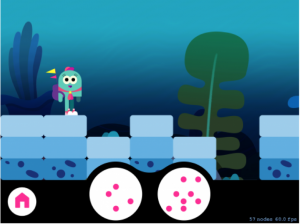This blog post is written by Professor Jill Porter, a Professor of Education at the University of Reading’s Institute of Education. It captures key research findings reported in her recently-published article.
Mathematical difficulties for children with Down syndrome
A number of children with Down syndrome experience particular difficulties with mathematics, and as a result learning to count may take many years. This can limit the development of important living skills as well as deprive them of an important problem solving tool. One promising approach is to encourage children’s awareness of quantity, a skill which does not rely on knowing the sequence of count words. From a very young age, humans are sensitive to differences in quantity and, as we get older, we get more and more precise in our judgements. Many researchers believe that this ability supports early mathematical development. So if we can find the right resources for children with Down syndrome we can improve this skill and ultimately help their mathematical understanding.
‘Millie Moreorless’ – a tablet game specifically for children with Down syndrome
Tablets have many advantages for teaching academic skills as they are easy to use and, with the right software, very engaging, but they have to provide the right level of challenge. There is little previous research about the design of specific educational software for children with Down syndrome. We know however that structured approaches, using small steps, can lead to successful mathematics learning for children with intellectual disabilities. We also know that games can provide fun opportunities for practising new skills. Armed with this knowledge, I worked collaboratively with two game designers and a creative studio Made in Me. Details of this process and the development of a new company Enabling Play, can be found here.
Our aim was to develop a game that was fun and engaging, which children with Down Syndrome would enjoy playing and which did not feel like a lesson or look like a work sheet. We compared how they engaged with the digital game to a simple card game, observed their interactions with the iPad and how many correct responses they made as we systematically added new features. Initially, we had a very simple game in which “Millie,” our intrepid space explorer, meets a range of obstacles as she walks across a planet. The player has to select the button with more dots to smooth her path. In the second version, we introduced sound and gave players some feedback (e.g. Millie shook her head and made a noise). We also changed the dots to a random arrangement to encourage children to make comparisons of relative number, rather than to try and count. In the third version, we introduced several new planets to explore. In order to lead children steadily to making more challenging judgements, we made the entry game easier by using quantities that varied more widely, but also introduced finding “less” as well as “more”. Millie was now Millie Moreorless. We also introduced a “Dynamic Difficulty Adjuster” so that the game was responsive to children’s mistakes.

Key findings
What did we find? Children found the use of the iPad very engaging with all but five of 67 children were able to access the game. Children actively explored the features of the display, but this could also be distracting, as they entered an Aladdin’s Cave of sensory feedback. To counteract this, we built into the game a range of rewards when children reached the end of the path (e.g. Millie danced, they got a collectable for a high score, which they could drag and drop into their digital rucksack). At the same time, the game got harder with success, the path that Millie walked along was longer with more obstacles and the choices of quantity became more difficult. This illustrates the ultimate task in developing educational software for children with learning difficulties, finding the optimal level of challenge. Without this, we found that some children gave up when they started to make mistakes, others stopped thinking about quantity and responded by always selecting the button on one side.
Practical implications of this research study
The research provides several important messages for the design of software for children who find learning difficult:
- attending to the clarity of the visual display and careful choice of icons (some, such as the home button, can be too attractive!);
- carefully adjusting the levels of difficulty: in relation to the target skill, in this case discriminating between two quantities; and also the length of the task (the path) before a reward is received;
- building in a dynamic adjuster that is responsive to children’s error patterns;
- widening the optional features so that the game can be personalised including choosing feedback and rewards that range in sophistication.
It is important to get these right, otherwise children may simply give up, when, with the right support, they can achieve important everyday skills.
Further reading

